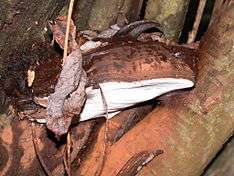Ganoderma brownii
Ganoderma brownii is a species of polypore fungus in the Ganodermataceae family. It is a plant pathogen and occasional saprotroph similar in appearance to Ganoderma applanatum. This species is restricted geographically to the Pacific Northwest, primarily observed in California. In the San Francisco Bay Area, it is very common on Umbellularia californica.
| Ganoderma brownii | |
|---|---|
 | |
| Scientific classification | |
| Kingdom: | |
| Division: | |
| Class: | |
| Order: | |
| Family: | |
| Genus: | |
| Species: | G. brownii |
| Binomial name | |
| Ganoderma brownii (Murrill) Gilb. (1962) | |
| Synonyms[1] | |
| |
Taxonomy
This fungus is a member of the G. applanatum group.
Description
It is a perennial, sessile, concentrically zonate polypore that is 5–65 cm (2.0–25.6 in) in length that can be a number of dull tones ranging from brown to gray.[2] It parasitizes both conifers and hardwoods, with a preference for the latter. Its pore surface is white but easily turns shades of brown upon damage. According to Michael Kuo, it has larger spores than G. applanatum, measuring 9–12 by 7–9 μm.
External links
- Ganoderma brownii images at Mushroom Observer
References
- "Ganoderma brownii (Murrill) Gilb. 1962". MycoBank. International Mycological Association. Retrieved 2011-12-24.
- Bessette, Alan R.; William Roody; Areleen Bessette; Dail Dunway (2007). Mushrooms of the Southeastern United States. Syracuse University Press. ISBN 978-0-8156-3112-5.